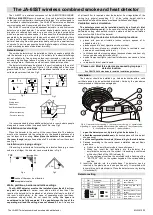
RP0193-2001
12
NACE International
bicarbonates, or nitrates in the electrolyte may also
affect the performance of zinc as an anode material.
7.3.6 Galvanic anode performance may be enhanced
in most soils by using special backfill material.
Mixtures of gypsum, bentonite, and sodium sulfate are
the most common.
7.3.7 Galvanic anodes (except for rebar-type anodes)
should be supplied with adequate lead wire attached by
the anode supplier.
7.3.7.1 Lead wire should be at least 2 mm in
diameter (#12 AWG [American Wire Gauge.])
Cable insulation should be selected based on the
anticipated environmental conditions and should
typically be resistant to oil and water.
________________________________________________________________________
Section 8: Design Considerations — Cathodic Protection for Tanks with Replacement Bottoms or
Release-Prevention Barriers
8.1 Introduction
8.1.1 Release-prevention barriers and replacement
tank bottoms can be used together or separately.
8.1.2 Release-prevention barriers and/or secondary
carbon steel tank bottoms may shield the carbon steel
surface of the primary tank bottom from the flow of
cathodic protection current, resulting in a lack of
adequate cathodic protection.
8.1.3 Any impact (i.e., corrosiveness) that the fill
material beneath or between the tank bottoms could
have on the cathodic protection system should be
considered.
8.2 Release-Prevention Barriers
8.2.1 Impervious membranes or liners constructed of
a nonconductive material used as a release-prevention
barrier can prevent the flow of cathodic protection
current from anodes located outside the barrier
envelope. Anodes must be placed between the barrier
and the carbon steel tank bottom so that current flows
to the surfaces requiring protection.
If release-prevention barriers made of conductive
material are used with a cathodic protection system
with anodes outside the space contained by the barrier,
the barrier must maintain a resistance low enough for
sufficient cathodic protection current to flow to the tank
bottom.
8.2.2 Stationary reference electrodes and/or portable
reference electrode insertion tubes must be located
between the carbon steel tank bottom and the barrier
or between the bottoms to obtain accurate structure-to-
electrolyte data.
8.3 Replacement Tank Bottoms
8.3.1 If a replacement tank bottom is installed in an
existing tank over an original bottom so that there is an
electrolyte between the two tank bottoms, galvanic
corrosion activity can develop on the new bottom,
resulting in premature failure.
8.3.2 Cathodic protection should be considered for the
primary (new) bottom.
The anodes and reference
electrodes
or
nonconductive
reference
electrode
insertion tubes must be placed in the electrolyte
between the two bottoms. Figure 8 illustrates a typical
double-bottom cathodic protection layout.
8.3.3 The installation of a nonconductive, impervious
membrane or liner above the original bottom reduces
galvanic corrosion activity on the replacement bottom,
reducing the current required for cathodic protection.
8.3.4 If the original tank bottom is removed and
replaced with a new bottom, the cathodic protection
design should be that utilized for a standard, single-
bottom tank.
Содержание CP 1
Страница 1: ...CP 1 Cathodic Protection Tester Course Manual February 2005 NACE International 2000 ...
Страница 265: ......
Страница 266: ......
Страница 267: ......
Страница 268: ......
Страница 301: ...RP0169 2002 32 NACE International ISBN 1 57590 035 1 ...
Страница 535: ...TM0101 2001 24 NACE International ISBN 1 57590 137 4 ...
















































